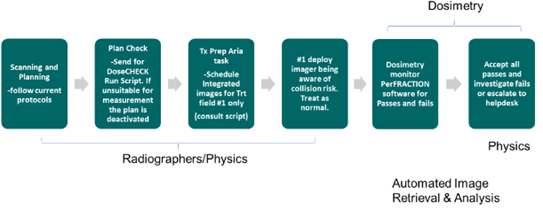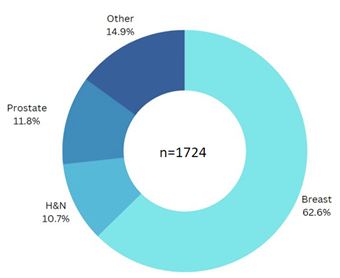In vivo dosimetry (IVD) in radiotherapy is a strong safety recommendation within the UK (Dept. of Health 2006 [1]) and a legal requirement in many European countries. Despite this, large-scale implementation and deployment of a service-wide IVD programme is challenging in terms of the required heavy lifting from physics associated with calibration and maintenance of dosimetry equipment, and troubleshooting out-of-tolerance results.
Motivations and Requirements
The team at Clatterbridge Cancer Centre is responsible for treatments in three centres across the Merseyside region in the UK, and implementation of an effective IVD service required automation, standardization and an interface that would support a team working both remotely and across multiple sites. SunCHECK supports these motivations through a web-based integrated Patient and Machine Quality Assurance Platform, and the SunCHECK Platform was the choice to bring these important safety checks to this busy centre with added efficiencies.
Finding the right criteria to apply
A guiding principle was to implement IVD as a safety check as opposed to a quality check, with the aim of catching gross errors in delivery, without spending too many hours analysing results. The IVD touchpoint is at the end of a tightly controlled chain, including daily image guidance for all patients, and the team was looking to prevent ‘alert fatigue’ where large numbers of false positives might lead to de-sensitization to any genuinely significant adverse events. As such, measurements are subject to relatively wide gamma pass criteria of 10% and 5mm at the panel.
SunCHECK transit dosimetry calculates the expected dose to be delivered at the MV panel and then automatically retrieves and compares, via gamma analysis, the measurement acquired during treatment before presenting the results to the end user. A process was established to review and approve results, with an escalation pathway for anomalous results to senior physics members following first-line troubleshooting. (Figure 1)

A nearly invisible safety check
Between July 2019 and October 2022, 9440 patients and over 22,000 treatment beams had automated IVD at Clatterbridge using SunCHECK. A recent study (Caines and Gilmore, 2023 [2]) showed that 1724 beams generated alerts in this period (~7% of patients). Using the established process and the automation within SunCHECK, first-line dosimetry review required approximately only 0.5-1 person-hours per day.

Common failure modes included off-axis panel placement, beam interruptions, and calibration drift. These failure modes were easily identified and corrected with a follow-up measurement. As noted in Figure 2, a large majority of the failures were breast treatments. (These patients are treated in voluntary breath hold with static-gantry tangential pair techniques; notably, Doolan et al. (2021 [3]) previously demonstrated that SunCHECK IVD can be more sensitive to small positional errors for static beams compared to VMAT.)
Escalation of failures and troubleshooting activity, inclusive of Medical Physics Expert Review, typically comprises only one person-hour per month. A handful of patients required investigation beyond routine troubleshooting, but no significant treatment errors were detected.
SunCHECK in vivo dosimetry has been implemented as a safety check within the broader context of patient and machine quality assurance. Our resource-constrained environment has allowed us to scale our in vivo dosimetry provision across our clinics, even as it remains largely invisible to end users.
For more information on this study, please see the following from ESTRO 2023: PO-1665, “When no news is good news: commercial automated EPID in vivo dosimetry deployed as a safety check”, R. Caines, M. Gilmore, The Clatterbridge Cancer Centre NHS Foundation Trust, Medical Physics, Liverpool, United Kingdom
About the Clatterbridge Cancer Centre
As a specialist oncology NHS Foundation Trust, the Clatterbridge Cancer Centre provides Radiotherapy Services to a catchment population of 2.4 million in Merseyside, UK, across three locations, generating approximately 100-120 new radiotherapy treatment plans per week and delivering 300-350 fractions per day across 10 linear accelerators.
Rhydian Caines, M.Sc., is a principal radiotherapy physicist at Clatterbridge with ten years of clinical experience. Rhydian takes a lead role in all aspects of the SunCHECK Patient platform, including secondary dose calculation and automated in vivo dosimetry, supporting the delivery of high-quality patient treatments across the centre’s three sites.
References:
[1] Donaldson LJ. Radiotherapy: Hidden Dangers. In 2006 Annual Report of the Chief Medical Officer. On the State of the Public Health. London, UK: The Department of Health; 2006:34–39.
[2] R. Caines, M. Gilmore, PO-1665 When no news is good news: commercial automated EPID in vivo dosimetry deployed as a safety check, Radiotherapy and Oncology, Volume 182, Supplement 1, 2023, Page S1367, ISSN 0167-8140, https://doi.org/10.1016/ S0167-8140(23)66580-6. (https://www.sciencedirect. com/science/article/pii/S0167814023665806)
[3] Doolan P, Nikolaou M, Ferentinos K, Anagnostopoulos G. Assessment of a commercial EPID dosimetry system to detect radiotherapy treatment errors. Biomed Phys Eng Express. 2021 Jun 1;7(4). doi: 10.1088/2057-1976/ac02a5. PMID: 34076586.